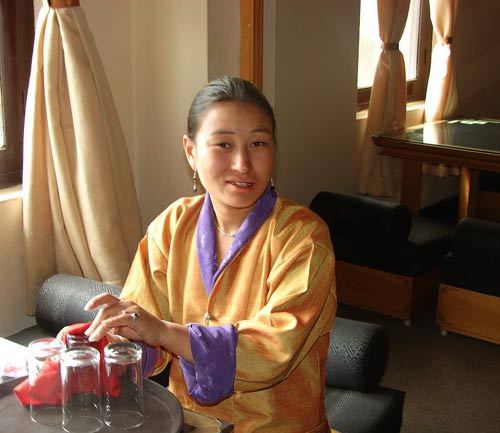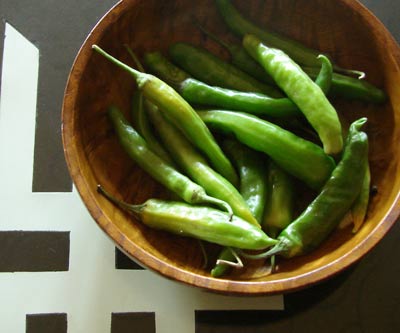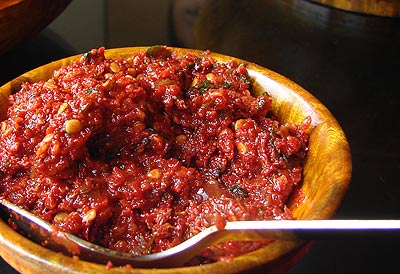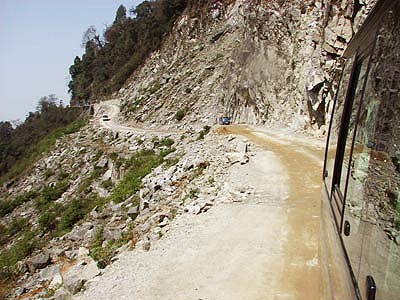 The entrance to Bhutan Kitchen Restaurant, showing a row of Bhuddist prayer wheels.
The entrance to Bhutan Kitchen Restaurant, showing a row of Bhuddist prayer wheels.
For some reason, all the restaurants we visit in Bhutan are not on street level, but rather on upper floors of three- or four-storey buildings. (No elevators, of course.) To get to each restaurant, both good and bad, we have to hike up dingy staircases where walls and floor seem to be the repository for the nasty habit of spitting out your bright red betel nut wherever you wish. After negotiating several off-putting flights of steps, we find the door into Restaurant Bhutan Kitchen. Mercifully, we find another world on the other side. There is no betel juice and no embarrassing artwork to pretend you do not see. The interior is spotless, comforting and immaculate. A patient woman in a beautiful silk jacket and long pencil skirt of dazzling color is busy shining glasses to perfection.
 Inside The Bhutan Kitchen all is spotless and aglow with hospitality.
Inside The Bhutan Kitchen all is spotless and aglow with hospitality.
The kitchen is a large room with a mish mash of Western and traditional cooking devices made out of heavy iron and wood. The chef is cooking on a massive wok independently powered by its own gas canister. Green Bhutanese Jitshe chiles (which taste very similar to Ancho chiles), onions, and garlic are quickly stir-fried in a little butter. When they are just limp, the chef adds about a cup of water. This is an unusual cooking technique but a very clever one, for it softens the chiles and onion quickly and distributes all the flavors evenly. He lets the dish simmer uncovered to really soften the chiles. All cooking stops here. The grated cheese is added but not stirred in. The pan is left on the stove with the heat off in order for the cheese to slowly melt in. This appears to be an important step in the process. He told us that the cheese should not cook, for if the heat is too high it will become stringy and rubbery. Finally, sliced cooked potatoes are added and folded in. The potatoes absorb the spicy aromatic pan juices, giving the potatoes a luscious flavor.
 Bhutanese jitshe chiles are a major ingredient of Ema Datshi.
Bhutanese jitshe chiles are a major ingredient of Ema Datshi.
This preparation of Ema Datshi is most unusual, and I can’t think of any American equivalent combining the stir-fry with the simmer process. The effect is amazing and enables the chiles to give off a lot of flavor into the rest of the dish; the potatoes in particular absorb a depth of flavor and spiciness in a short amount of time.
As if Ema Datshi is not hot enough, it is served with a very fiery condiment called Esay, the main ingredient being the Sichuan peppercorn mixed with tomato paste and onion. It reminded me of Moroccan Harissa, which would be an excellent substitute.
Bhutanese meals are always family style affairs, and a whole array of food is served along with Ema Datshi. A wonderful bright pink rice and baked onions round out the meal.
After this fabulous meal of Ema Datshi, Esay and wonderful Bhutanese Red Rice plus other assorted vegetarian dishes, we decide to take the easy way out. We drive on a smooth paved road, and in 30 minutes we are in Paro, the capitol city of Bhutan. We hop on a plane and, like eagles, we soar over those impossible roads of our entry and back to reality.
My new book, Somewhere South of Tuscany, is doing well! You can view it on my website www.DianaGArmstrong.com.
Ema Datshi
This is Bhutanese Comfort Food! It may also be the simplest dish you will ever make.
4 tablespoons butter (divided)
1 large red onion, sliced
2 cloves garlic, chopped
2 cups small, hot, finger-size green chiles (Bhutanese Jitshe chiles or Ancho chiles)
1 cup water
6 ounces Bhutanese Datshi or crumbled mild goat cheese
6 ounces grated pecorino or Gouda cheese
4 small potatoes, peeled, sliced 1/4″ thick and cooked in salted water
1/2 cup milk mixed with 1 tsp. flour
In a heavy pan over high heat, add the onions, garlic and green chiles with half of the butter and stir briefly so the butter coats the ingredients. Reduce heat to low and simmer until ingredients are just soft. Add the water. Cover and simmer for 20 minutes. Remove from heat and add the cheese but do not stir it in. Cover and let sit on the stove for 5 minutes. Now add the cooked, hot potatoes and remaining butter (do not stir) and let sit covered for an additional couple of minutes. Add the milk mixed with the flour, stir gently and serve hot.
Esay Paste

Here is a very spicy condiment from Bhutan that is similar to Moroccan Harissa.**
2 tablespoons Sichuan peppercorns*
1 minced onion
1/2 cup tomato paste
1/4 cup Asian fish sauce*
Blend together and serve. Keep refrigerated, serve cold as a condiment.
Makes about 1 cup of paste.
*Available from any Chinese market
**For other recipes that are similar to Harissa, read the article “Mighty Mauritian Mazavaroo.”





